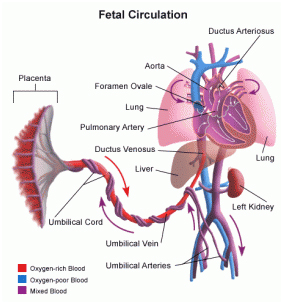What is umbilical cord?

The umbilical cord connects a baby in the womb to its mother. It runs from an opening in your baby’s stomach to the placenta in the womb.
What does the umbilical cord do?
In the placenta, oxygen and nutrients from your bloodstream pass into your baby's bloodstream and are carried to your baby along the umbilical cord.
Blood circulates through vessels in the cord, which consists of:
- one vein that carries blood rich in oxygen and nutrients from you to your baby
- two arteries that return deoxygenated blood and waste products, such as carbon dioxide, from your baby back to the placenta
These blood vessels are enclosed and protected by a sticky substance called Wharton’s jelly, which itself is covered by a layer of membrane called the amnion. Towards the end of your pregnancy, the placenta passes antibodies through the umbilical cord from you to your baby, giving it immunity from infections for about three months after birth. However, it only passes on antibodies that you already have.
- At full term, the cord is about 50 cm long and 1-1.5 cm thick.
- Your baby does not feel anything when the cord is cut after the birth.
- After the birth, when your baby breathes, the cord has no further function though it provides him with extra blood and oxygen until
it is clamped.
|